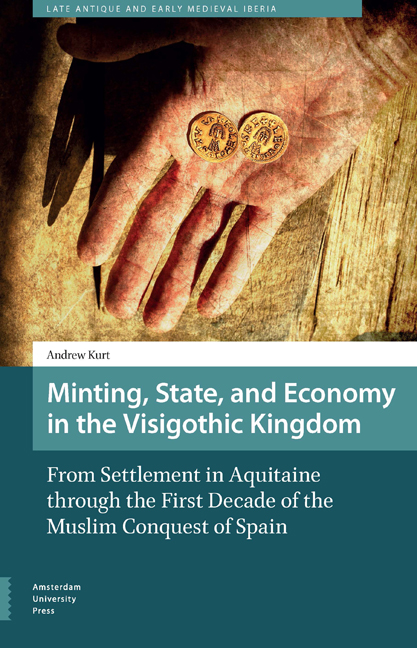 Minting, State, and Economy in the Visigothic Kingdom
Minting, State, and Economy in the Visigothic Kingdom Book contents
- Frontmatter
- Contents
- List of figures
- Acknowledgments
- Introduction
- 1 Pre-Regal Visigothic Coinage
- 2 The King’s Coinage: The Beginning and Development of theRegal Coinage (c. 573-c. 720) 81 A The Transition to a Regal
- 3 The Activities of the Mints from c. 573- c. 720
- 4 Why Were Gold Coins Struck in the Visigothic Kingdom?
- 5 The Royal Control of Visigothic Minting
- 6 Coinage in Spain in the Aftermath of the Islamic Conquest
- 7 Visigothic Currency in the Early Medieval Economy
- Conclusion
- Appendix I
- Appendix II
- Bibliography
- About the Author
- Index
1 - Pre-Regal Visigothic Coinage
Published online by Cambridge University Press: 21 November 2020
- Frontmatter
- Contents
- List of figures
- Acknowledgments
- Introduction
- 1 Pre-Regal Visigothic Coinage
- 2 The King’s Coinage: The Beginning and Development of theRegal Coinage (c. 573-c. 720) 81 A The Transition to a Regal
- 3 The Activities of the Mints from c. 573- c. 720
- 4 Why Were Gold Coins Struck in the Visigothic Kingdom?
- 5 The Royal Control of Visigothic Minting
- 6 Coinage in Spain in the Aftermath of the Islamic Conquest
- 7 Visigothic Currency in the Early Medieval Economy
- Conclusion
- Appendix I
- Appendix II
- Bibliography
- About the Author
- Index
Summary
Abstract
Chapter One examines the minting of gold under the Visigoths in Gaul up to the battle of Vouillé (507), then in Spain and southwestern Gaul in the first three quarters of the sixth century. The first stage within this so-called pre-regal period was characterized largely by imitation of Roman coinage, while the second stage saw a departure from strict imitation, especially of the reverse tremissis type of the Roman Victory goddess. The chapter reviews Visigothic attribution of gold coins over the entire period; the weight and gold purity of these solidi and tremisses are shown to be well below Roman standards. Fluctuating weights and gold analyses of a large number of specimens tested indicate expansion of the mint system.
Keywords: Kingdom of Toulouse; solidus; tremissis; attribution; weights; imitation
The Fifth-Century Kingdom in Gaul
The Emergence and Growth of the Visigothic Kingdom
A study of the monetary culture of the Visigothic kingdom over its long course begins concretely with the Goths’ settlement first in the western Gallic provinces in the early fifth century and later in Hispania, in tandem with consideration of their relations with the Roman Empire. There is, however, a Gothic history prior to these pivotal episodes that has some bearing on the subject under discussion. Much of this revolves around the migration into the Empire in 376 of Goths, or primarily a portion of a people sometimes identified as their ancestors (the Tervingi), and the subsequent troubled relationship with imperial authorities who had permitted their crossing south of the Danube. This is highlighted first by the battle of Adrianople in 378 in which Gothic victory entailed emperor Valens's death and second by the assault on Rome under Alaric in 410. Today, basic questions persist as to whether ‘Goths’ actually existed before the Danube crossing and who they were in the years that followed, what their real association was with other groups north of the river both culturally and in terms of the mass movements of this era, and what role all the barbarian migrants played in the demise of the western Empire.
- Type
- Chapter
- Information
- Minting, State, and Economy in the Visigothic KingdomFrom Settlement in Aquitaine through the First Decade of the Muslim Conquest of Spain, pp. 25 - 80Publisher: Amsterdam University PressPrint publication year: 2020


